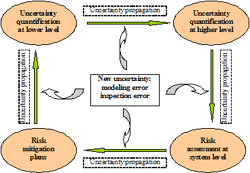 Introduction: This study, sponsored by the FAA, develops a comprehensive and systematic risk assessment and management methodology for rotorcraft damage tolerance (RCDT). This will support FAA's rulemaking regarding the future implementation of RCDT-based design and maintenance. The outcomes of the proposed study will also be beneficial to enhance the continued airworthiness and economical operations of rotorcraft. The traditional damage tolerance (DT) approach to aircraft structures assumes a deterministic damage accumulation process where deterministic crack growth curves, constant material properties, and specific initial flaw sizes are used. However, the fatigue damage accumulation process is stochastic in nature. The uncertainty quantification of fatigue damage and its effect on structural safety needs to be carefully included in RCDT risk assessment. The probabilistic method is more appropriate for RCDT since it can properly account for various uncertainties and assist the decision-making process with respect to design and maintenance scheduling.
Introduction: This study, sponsored by the FAA, develops a comprehensive and systematic risk assessment and management methodology for rotorcraft damage tolerance (RCDT). This will support FAA's rulemaking regarding the future implementation of RCDT-based design and maintenance. The outcomes of the proposed study will also be beneficial to enhance the continued airworthiness and economical operations of rotorcraft. The traditional damage tolerance (DT) approach to aircraft structures assumes a deterministic damage accumulation process where deterministic crack growth curves, constant material properties, and specific initial flaw sizes are used. However, the fatigue damage accumulation process is stochastic in nature. The uncertainty quantification of fatigue damage and its effect on structural safety needs to be carefully included in RCDT risk assessment. The probabilistic method is more appropriate for RCDT since it can properly account for various uncertainties and assist the decision-making process with respect to design and maintenance scheduling.
 Methodology: The overall objectives of the project are to develop, validate, and implement a general risk assessment and management methodology for rotorcraft damage tolerance. The project is composed of four major components: (1) Uncertainty Quantification at the material level, (2) Uncertainty Propagation to the component/structural level, (3) Risk assessment at system level, and (4) Risk management actions (inspection and maintenance planning). Task 1 will investigate the uncertainties in the various input quantities to the RCDT methodology. Uncertainties include but are not limited to equivalent initial flaw shapes, sizes, and locations, fatigue crack threshold stress intensity factors, loading spectra, structural geometries, manufacturing process variables, and environmental effects. Task 2: Uncertainty propagation to component/structural level will analyze analytical and computational methods, fracture mechanics, and random process theory to develop a suitable methodology to evaluate the effects of uncertainty propagation on fatigue life prediction under simulated service conditions. Task 3: Risk assessment at system level will examine analytical methods, response surface methods and efficient Monte Carlo methods to develop an efficient and accurate methodology for reliability estimation of the rotorcraft system. Task 4 will develop a general methodology for reliability-based inspection optimization (RBIO) based on the analytical and experimental results described in tasks 1 to 3.
Methodology: The overall objectives of the project are to develop, validate, and implement a general risk assessment and management methodology for rotorcraft damage tolerance. The project is composed of four major components: (1) Uncertainty Quantification at the material level, (2) Uncertainty Propagation to the component/structural level, (3) Risk assessment at system level, and (4) Risk management actions (inspection and maintenance planning). Task 1 will investigate the uncertainties in the various input quantities to the RCDT methodology. Uncertainties include but are not limited to equivalent initial flaw shapes, sizes, and locations, fatigue crack threshold stress intensity factors, loading spectra, structural geometries, manufacturing process variables, and environmental effects. Task 2: Uncertainty propagation to component/structural level will analyze analytical and computational methods, fracture mechanics, and random process theory to develop a suitable methodology to evaluate the effects of uncertainty propagation on fatigue life prediction under simulated service conditions. Task 3: Risk assessment at system level will examine analytical methods, response surface methods and efficient Monte Carlo methods to develop an efficient and accurate methodology for reliability estimation of the rotorcraft system. Task 4 will develop a general methodology for reliability-based inspection optimization (RBIO) based on the analytical and experimental results described in tasks 1 to 3.
Application: The above objectives incorporate implementation and validation with practical rotorcraft material, component and system, in collaboration with industrial partner, Bell Helicopter Textron Inc. The objectives will help assist FAA rulemaking and are directly connected to FAR 29.571 (fatigue evaluation). The project will also help to determine the optimum inspection schedule to ensure the structural reliability level meets or exceeds industry standards.
Article on FAA Rotorcraft Project